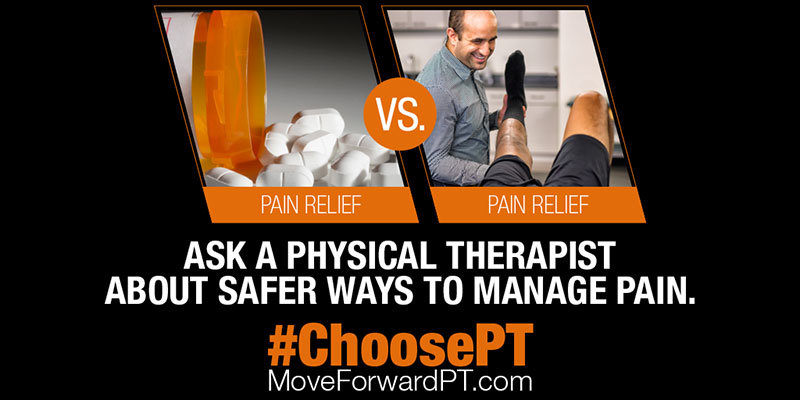Do Physical Therapists treat chronic pain more effectively than prescription drugs?
As the United States comes to grips with an unprecedented increase in prescription drug addictions, patients and doctors are advocating for alternative treatments for chronic pain. The APTA launched their #ChoosePT Campaign in June 2016, to highlight the benefits of Physical Therapy as an alternative treatment for chronic pain. Since the risks of opioid use include depression, overdose, and addiction, plus withdrawal symptoms when stopping use, using physical therapy instead of pain medications can prevent some pretty severe problems – especially when you consider that people addicted to prescription opioids are 40 times more likely to become addicted to heroin.
However, the APTA’s #ChoosePT campaign raises some challenges and questions about using physical therapy to treat chronic pain as well. Interestingly, many of these challenges come from Physical Therapists themselves, especially those who feel that the PT profession doesn’t do enough to educate and train physical therapists in effectively treating patients with chronic pain.
Key Research Challenges Current Understanding of Chronic Pain
According to Steven Z. George, PT, PhD, in order to meet the challenge of treating the 116 million American who experience chronic pain each year, physical therapists need a transformation of their understanding and treatment methods for pain. In his 2016 John H.P. Maley Lecture: “Pain Management: Roadmap to Revolution,” George, highlights key research that challenges our current understanding of pain and gives some suggestions for how our treatment of pain should change. Here’s a brief overview:
First, Physical Therapists need to start by changing how they view pain. Our current model is: Pain = nociception = tissue injury. However, this paradigm doesn’t fully explain the complexity of pain. According to the American Pain society, “individual response to pain is the norm.” And, “individual pain responses are the norm even when standard stimulus is used.” In other words, “pain is defined by social context, individual beliefs and emotions,” not just a physical stimulus.
In my clinical experience, I’ve certainly experienced the truth of this insight. Patients present wide variations in pain to even in the most common procedures. Each patient’s response to a hip fracture, TKA, THA, Rotator cuff repair and lumbar spinal fusion vary widely in pain. George reports a study where a 49 degree Celsius stimulation was given to subjects. Patients reported on a 0-100 pain scale. The entire range of the scale was reported! George advocates that we need a different pain map to explain the wide variation.
For example, Irene Tracy’s pain map measures the following four indicators:
a. Context
b. Cognitive state
c. Mood
d. Chemical and structure
Suggestions for Changes in Physical Therapy Education
Steven George also believes that we need transformational change in physical therapy education to better service our patients and society as a whole. First, George recommends that physical therapy schools should add increased hours in understanding pain and educating on more accurate pain mapping to better train physical therapy graduates. Second, he calls for current physical therapists to gain expertise in pain management through continuing education to better serve our patients. Third, George advocates for research studies to focus on the study of pain and movement together instead of separately.
So, since physical therapists obviously have a lot to learn about treating chronic pain, how do we set realistic expectations for ourselves and our patients? George quotes Thomas Lee in a recent JAMA publication, “Zero pain is not the goal but the reduction of suffering is- and that is more complex than analgesia alone.” Our value as a profession deepens, says George, when we can limit acute pain from becoming chronic and improving the quality of life of the chronic pain patient without excessive costs.
Steven George concludes his presentation by reporting characteristics of the ideal medical provider in treating pain as one who:
1. Differentiates pain and suffering
2. De-Medicalizes pain in most cases
3. Utilizes hands on treatment
When APTA President, Sharon L. Dunn, PT, DPT, OCS, announced the launch of the campaign during her address to the APTA House of Delegates on June 6, she described the current opioid epidemic as “a crucial window of opportunity for our profession – a chance to step forward and assume the massive responsibility of treating the millions of Americans in pain without the real dangers of prescription opioids, and a chance to let the public know that when it comes to treatment for pain, they do have a choice, and that choice can be physical therapy.” Putting Steven George’s suggestions into practice will ensure that when patients come to us for help with chronic pain, we’ll be able to fulfill their expectations.
What are your thoughts on treating patients with chronic pain? What continuing education classes have you found most helpful in gaining skills in this area? Please share your thoughts and experiences in the comment section below. Thanks!



